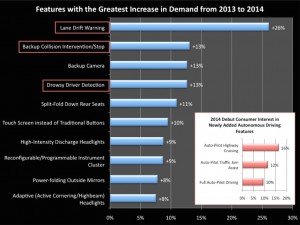
Auto Pacific's new FADS survey shows an increase in drivers wanting advanced safety systems on vehicles.
While a self-driving car may be in our future, for now drivers just want for some additional safety help as they’re motoring along America’s highways and byways, according to a new study.
The top desired features showing the largest growth are lane drift warning systems and backup collision intervention, backup cameras and drowsy driver monitoring systems.
The lane drift warning was the biggest riser in Auto Pacific’s annual Future Attribute Demand Study (FADS). The demand jumped 26% from 2013 to 2014, the company said.
The other three aforementioned items all jumped 13% on a year-over-year basis.
The study also found that most Americans aren’t ready for autonomous cars – just 10% said they wanted a self-driving vehicle – many of the features they want in a new vehicle are simply the first steps toward that kind of experience.
Items such as rain sensing windshield wipers to backup collision intervention to full autonomous driving, each provide a level of assistance independent of the driver, the company said.
AutoPacific’s FADS currently surveys 15 features related to autonomous driving, including three new features: auto-pilot traffic jam assist, auto-pilot highway cruising and full auto-pilot driving, each debuting with greater than 10% interest from consumers.
(Nissan won’t wait for 2020 to being rolling out autonomous technologies. For more, Click Here.)
“FADS is designed to provide the planner, market strategist and product development expert with information essential to defining successful future vehicles for the U.S. market,” said George Peterson, president of AutoPacific.
Acceptance and comfort with those types of technologies will be pivotal the success of autonomous vehicles. A recent study from Navigant Research predicts global annual sales of autonomous vehicles could reach 95 million by 2035.
(Click Here for details on desire of buyers for vehicles with troublesome technology.)
While Google is considered the early leader in the development of self-driving vehicles and claims it will have vehicles ready by 2025, Nissan’s chief, Carlos Ghosn, said the maker would be ready a little sooner: 2020.
“By the end of 2016, Nissan will make available the next two technologies under its autonomous drive strategy,” said Ghosn.
(To see more about GM recalling another 717,000 vehicles, Click Here.)
“We are bringing to market a traffic-jam pilot, a technology enabling cars to drive autonomously – and safely – on congested highways,” he explained. “In the same timeframe, we will make fully-automated parking systems available across a wide range of vehicles.”
The company surveys more than 92,000 new vehicle owners to determine what they’ll want in their next vehicle. More than 100 features are surveyed, ranging from backup camera and drowsy driver detection, to auto-pilot driving. Plus, it asks for additional information about future preferences for engine type, engine size and transmission.

If you can’t keep your car in the proper lane then you should take the bus because you’re not paying attention to driving.